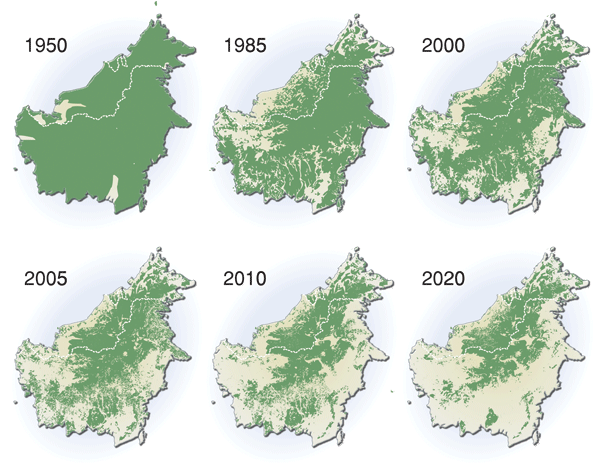Indonesia’s vanishing forests
A devastating logging campaign, driven by the demand of developed countries for timber, pulp and plywood, wiped out 40 percent of Indonesia’s forests between 1950 and 2000.

Extent of deforestation in Borneo 1950-2005, and projection towards 2020. In UNEP/GRID-Arendal Maps and Graphics Library. Find it at www.grida.no.
Indonesia’s vanishing forests
A devastating logging campaign, driven by the demand of developed countries for timber, pulp and plywood, wiped out 40 percent of Indonesia’s forests between 1950 and 2000.
From 1950 to 2000, 40 percent of Indonesia’s forests were cleared. This devastating logging campaign was driven by the demand of developed countries for timber, pulp and plywood and a willingness by Indonesian President Suharto to grant logging concessions throughout his three-decade term (1967 – 1998).
In the ’90s, along with corn, soybeans, and sugarcane, palm oil was seen as a green alternative to fossil fuels. Between 2000 and 2005, about 20 square miles of Indonesian rain forest was destroyed daily to plant oil palm. In the name of conservation, an area of rain forest about the size of Manhattan was cleared every single day.
Unfortunately, the quest to lessen greenhouse gases and decrease global warming with biofuel crops has backfired, because forests are the planet’s carbon banks. Logging the forest for planting new crops releases the carbon formerly sequestered in living trees, roots and leaves. Slash and burn agriculture, the traditional mode of farming in Indonesia, causes even more massive carbon emissions. Carbon or CO2 is the primary greenhouse gas responsible for global warming.
Related story:
Jungle calling

Your comments are welcome
Comments
Related Reading:
Features
A Prescription for Success
TCU’s health policy program from the Neeley School of Business trains medical industry professionals in the business of health care.
Features
Campus of the Future
TCU’s Campus Master Plan builds on the university’s vision and values.